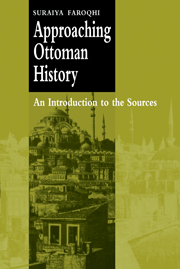Book contents
- Frontmatter
- Contents
- List of illustrations
- Acknowledgements
- 1 Introduction
- 2 Entering the field
- 3 Locating Ottoman sources
- 4 Rural life as reflected in archival sources: selected examples
- 5 European sources on Ottoman history: the travellers
- 6 On the rules of writing (and reading) Ottoman historical works
- 7 Perceptions of empire: viewing the Ottoman Empire through general histories
- 8 Conclusion
- References
- Index
8 - Conclusion
Published online by Cambridge University Press: 10 November 2009
- Frontmatter
- Contents
- List of illustrations
- Acknowledgements
- 1 Introduction
- 2 Entering the field
- 3 Locating Ottoman sources
- 4 Rural life as reflected in archival sources: selected examples
- 5 European sources on Ottoman history: the travellers
- 6 On the rules of writing (and reading) Ottoman historical works
- 7 Perceptions of empire: viewing the Ottoman Empire through general histories
- 8 Conclusion
- References
- Index
Summary
FURTHER DESIDERATA
Obviously the discussion of sources, both primary and secondary, as attempted in the present volume does not nearly exhaust our subject. Some readers will regret that miniatures, mosques, palaces and photographs have not been discussed, and it is true that this type of source has been gaining in importance with every passing year. During the last two decades or so, many historians of Ottoman art have given up the purely descriptive approach favoured in the 1960s or 1970s. Architectural historians have also abandoned the exclusive concern with building structure typical of that time.
At present, quite a few researchers dealing with Ottoman images try to place the objects studied in a context, either political or social. Such an interest encourages forays into the territory otherwise occupied by historians. To mention but one example, the Ottoman dynasty, with no links to the prestigious rulers of the early caliphate or the mediaeval Middle East, attempted to legitimise itself by sumptuous public building: this phenomenon is of obvious interest to both political and art historians. Or else miniatures, fayence or carpets constitute luxury goods as well as works of art. Here the interest that ‘straight’ historians have recently been taking in consumption has tended to bring art historians into contact with their colleagues from neighbouring disciplines.
In a different vein, the critical attitude of post-colonial historians toward the creation of myths and images has made Ottomanists aware of the fact that no less than written sources, images must be carefully analysed before they can be put to use. In consequence, critical studies of image making, especially of photography, have become quite frequent (for a good example, see Beauge, Çizgen, [1992]).
- Type
- Chapter
- Information
- Approaching Ottoman HistoryAn Introduction to the Sources, pp. 204 - 221Publisher: Cambridge University PressPrint publication year: 1999

